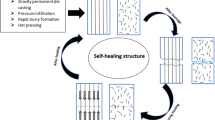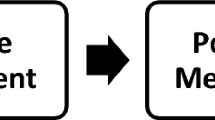Abstract
The change in the microhardness over the thickness of samples made of EDT-69N binder cured in vacuum and at atmospheric pressure at temperatures from 130 to 170°C was investigated. It was found that the change in microhardness along the thickness of the samples occurs according to a parabolic law, with the maximum values being achieved in the middle of the sample cross section along the thickness. With an increase in the molding temperature, the microhardness in the middle section of the sample increases from 222 MPa at a molding temperature of 130°C to 410 MPa during molding at 170°C. At the critical molding temperature (170°C), the microhardness in all zones of the specimen cross section (subsurface, semi-average, and core) levels off, while the parabolic dependence degenerates into a straight line. It is shown that the method of scratching (sclerometry) demonstrated a fairly high sensitivity to the state of samples cured at different temperatures. With an increase in the molding temperature, the width of the sclerometric grooves decreases. At the critical molding temperature of 170°C, the groove width is stabilized and becomes constant throughout the sample thickness. To characterize the difference in the values of the microhardness of the cured binder in the sample volume, it is proposed to use a dimensionless “coefficient of volume anisotropy,” which can take a positive, negative, or zero value. With an increase in the curing temperature of the binder and, accordingly, with an increase in the microhardness of the sample, the coefficient of volume anisotropy decreases, and when the samples are molded at the critical temperature, it goes to zero, which indicates the absence of anisotropy.





Similar content being viewed by others
REFERENCES
Raskutin, A.E., Development strategy of polymer composite materials, Aviats. Mater. Tekhnol., 2017, no. S, pp. 344–348. https://doi.org/10.18577/2071-9140-2017-0-S-344-348
Kablov, E.N., Strategic directions for the development of materials and technologies for their processing for the period up to 2030, Aviats. Mater. Tekhnol., 2012, no. S, pp. 7–17.
Grashchenkov, D.V., Strategy of development of non-metallic materials, metal composite materials and heat-shielding, Aviats. Mater. Tekhnol., 2017, no. S, pp. 264–271. https://doi.org/10.18577/2071-9140-2017-0-S-264-271
Veshkin E.A., Postnov V.I., Semenychev V.V., Krashe-ninnikova E.V. Analysis of some characteristics of polymer concrete by unconventional methods, Klei, Germet., Tekhnol., 2018, no. 2, pp. 29–34.
Raskutin, A.E., Russian polymer composite materials of new generation, their exploitation and implementation in advanced developed constructions, Aviats. Mater. Tekhnol., 2017, no. S, pp. 349–367. https://doi.org/10.18577/2071-9140-2017-0-S-349-367
Mukhametov, R.R., Akhmadieva, K.R., Kim, M.A., and Babin, A.E., Melt binders for advanced production methods for PCM of new generation, Aviats. Mater. Tekhnol., 2012, no. S, pp. 260–265.
Kablov, E.N., Istoriya aviatsionnogo materialovedeniya. VIAM – 80 let: Gody i lyudi (History of Aviation Materials Science. VIAM–80 Years: Years and People), Moscow: VIAM, 2012.
Kablov, E.N. Istoriya aviatsionnogo materialovedeniya: VIAM – 75 let poiska, tvorchestva, otkrytii (History of Aviation Materials Science. VIAM–75 Years of Search, Creativity, Discovery), Moscow: Nauka, 2007.
Platonov, A.A., Kogan, D.I., and Dushin, M.I., The manufacture of three-dimensional PCM by the method of impregnation with a film binder, Plast. Massy, 2013, no. 6, pp. 56–61.
Dushin, M.I., Khrul’kov, A.V., Mukhametov, R.R., Selected technological parameters for the autoclave molding of polymer composites materials, Aviats. Mater. Tekhnol., 2011, no. 3, pp. 20–26.
Kuritsyna, A.D., Primenenie metoda mikrotverdosti dlya opredeleniya nekotorykh svoistv polimernykh materialov. Metody ispytaniya na mikrotverdost’ (Application of the Microhardness Method to Determine Some Properties of Polymeric Materials. Microhardness Test Methods), Moscow: Nauka, 1965.
Krumova, M., Klingshirn, C., Haupert, F., and Friedrich, K., Microhardness studies of functionally graded polymer composites, Compos. Sci. Technol., 2001, vol. 61, pp. 557–563.
Goyal, R.K., Tiwari, A.N., and Negi, Y.S., Microhardness of PEEK/ceramic micro- and nanocomposites: Correlation with Halpin–Tsai model, Mater. Sci. Eng., A, 2008, vol. 491, nos. 1–2, pp. 230–236.
Veshkin, E.A., Postnov, V.I., Semenychev, V.V., Krashe-ninnikova, E.V., Research of microhardness and sclerometric characteristics of the binding UP-2227N, cured by different regimes, Aviats. Mater. Tekhnol., 2018, no. 1, pp. 39–45. https://doi.org/10.18577/2071-9140-2018-0-1-39-45
Veshkin, E.A., Postnov, V.I., and Semenychev, V.V., Evaluating the microhardness of samples based on binder VST-1210 cured under various conditions as a method of testing, Inorg. Mater.: Appl. Res., 2019, vol. 10, pp. 127–130. https://doi.org/10.1134/S2075113319010386
Semenichev, V.V., Veshkin, E.A., and Postnov, V.I., Application of sclerometry for evaluation of adhesion of nickel coating to fiberglass, Perspekt. Mater., 2017, no. 12, pp. 75–81.
Weaver, C., Adhesion of thin films, J. Vac. Sci. Technol., 1975, vol. 12, no. 1, pp. 18–25.
Mostovoi, A.S. and Ledenev, A.N., Modification of epoxy polymers by nanodispersed silicon, Fiz. Khim. Obrab. Mater., 2017, no. 4, pp. 61–66.
Savvinova, M.E., Polymer composites for electrotechnical purposes, Fiz. Khim. Obrab. Mater., 2016, no. 3, pp. 52–56.
Kudinov, V.V., Krylov, I.K., Mamonov, V.I., and Korneeva, N.V., Increase in impact toughness of carbon fiber reinforced plastics, Fiz. Khim. Obrab. Mater., 2016, no. 1, pp. 64–67.
Tager, A.A., Fiziko-khimiya polimerov (Physical Chemistry of Polymers), Moscow: Nauchnyi Mir, 2007.
Vul’f, B.K. and Romadin, K.P., Aviatsionnoe materialovedenie (Aviation Materials Science), Moscow: Mashinostroenie, 1967.
Quenouille, M.H., Rapid Statistical Calculations: A Collection of Distribution-Free and Easy Methods of Estimation and Testing, London: Griffin, 1959.
Kablov, E.N., Innovations of VIAM as part of implementing the Strategic Directions of Development of Materials and Technologies of Their Processing for the Period up to 2030, Aviats. Mater. Tekhnol., 2015, no. 1, pp. 3–33. https://doi.org/10.18577/2071-9140-2015-0-1-3-33
ACKNOWLEDGMENTS
This study was carried out within implementation of complex research area 13.1 “Binders for Polymer and Composite Materials of Structural and Special Assignment” (Strategic Directions for the Development of Materials and Technologies for Their Processing for the Period up to 2030 [24]).
Author information
Authors and Affiliations
Corresponding author
Additional information
Translated by K. Gumerov
Rights and permissions
About this article
Cite this article
Veshkin, E.A., Postnov, V.I., Semenychev, V.V. et al. Regularities of Changes in Microhardness in the Volume of EDT-69N Binder Cured at Different Temperatures. Inorg. Mater. Appl. Res. 12, 831–835 (2021). https://doi.org/10.1134/S2075113321030370
Received:
Revised:
Accepted:
Published:
Issue Date:
DOI: https://doi.org/10.1134/S2075113321030370




